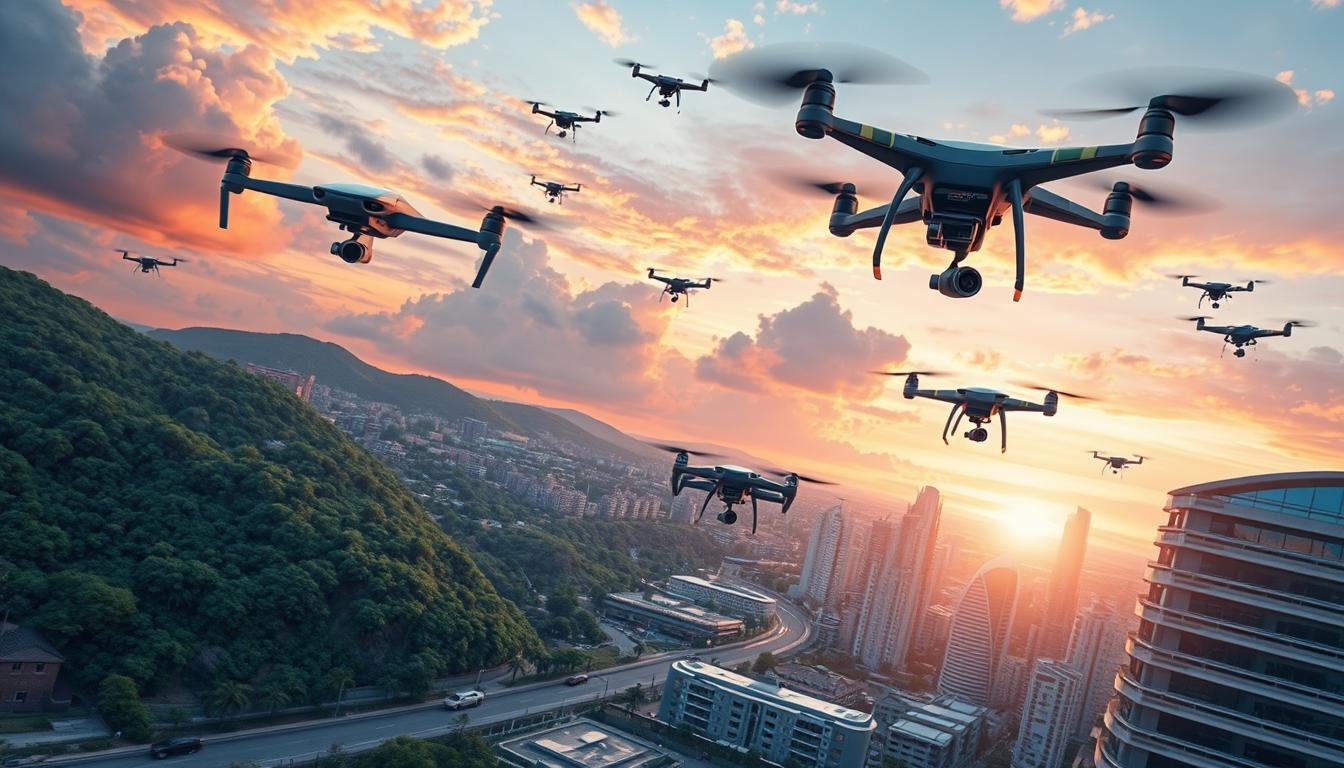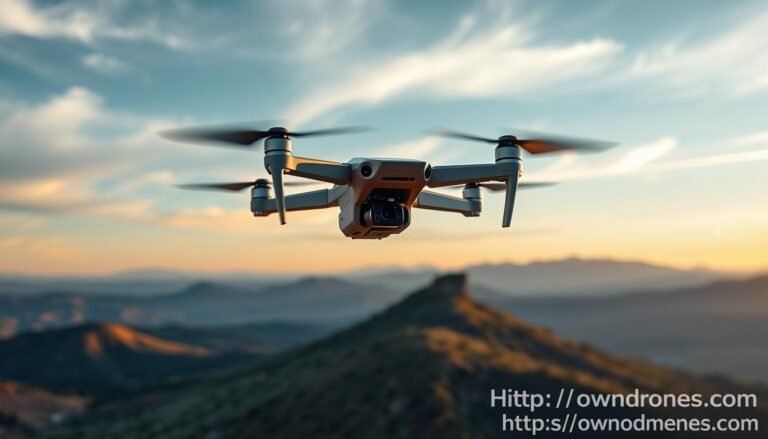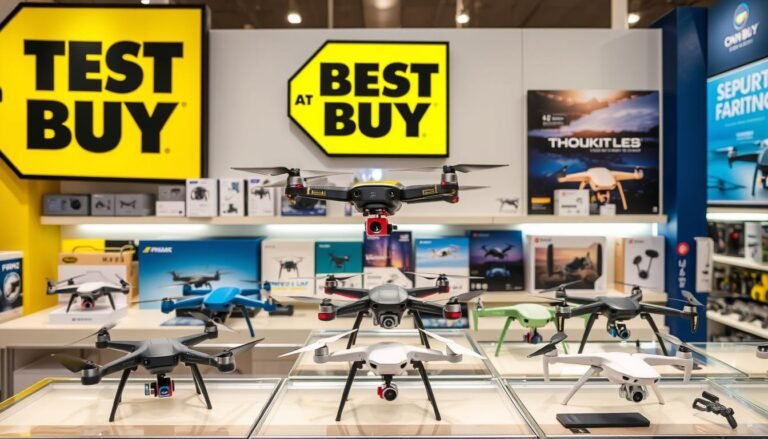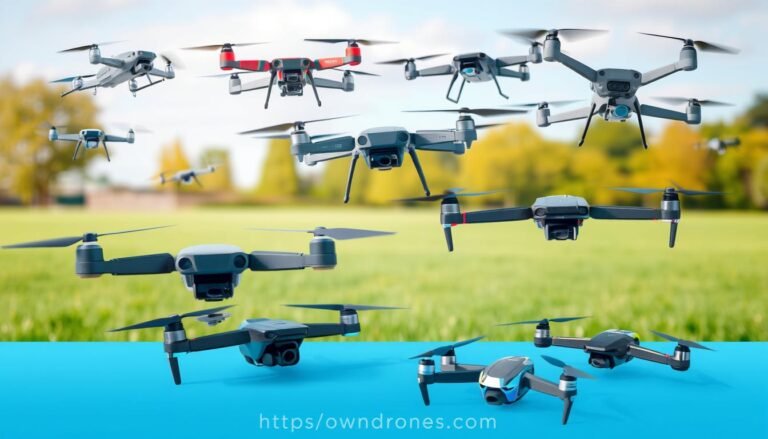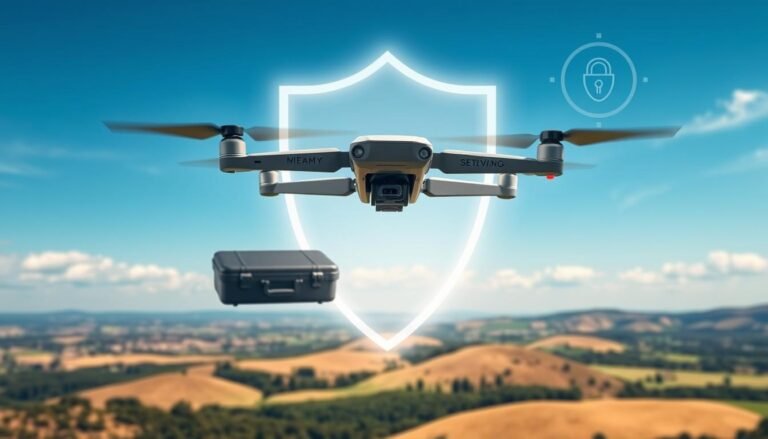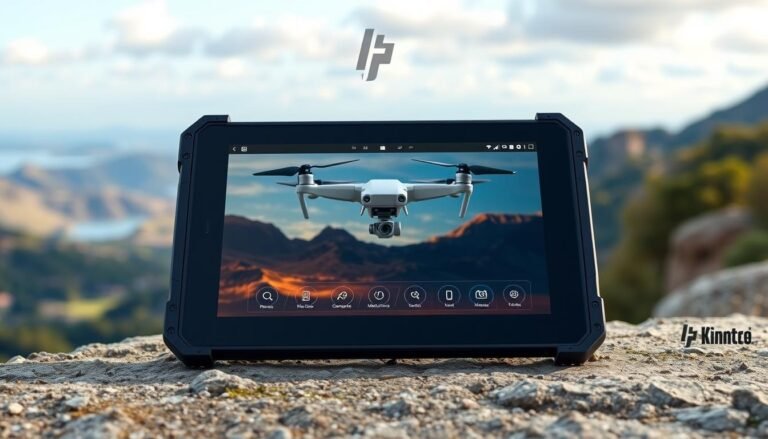Discover the Magic of What Are Flying Drones
Did you know that unmanned aerial vehicles, or uavs, started in 1898? Nikola Tesla created a four-foot-long model of a torpedo boat. It could be controlled with a switchboard key. This was the start of a new era in aviation.
Today, drones are a big part of our lives. They change how we take aerial footage and do many activities. With better technology, drones are now easier to get and use. They are loved by both hobbyists and professionals.
Exploring what-are-flying-drones shows many benefits. They help take amazing aerial photos and give insights in fields like construction and agriculture. For the best drone deals, check out https://mavely.app.link/e/2RKE62lxXOb. For the latest uavs news, visit https://owndrones.com often.
Key Takeaways
- Drones have a rich history, dating back to 1898 with Nikola Tesla’s invention.
- Unmanned aerial vehicles, or uavs, have become increasingly popular for both recreational and professional use.
- Drones offer a wide range of benefits, including stunning aerial photography and valuable industry insights.
- To get the best drone prices, visit https://mavely.app.link/e/2RKE62lxXOb.
- Stay updated on the latest uavs information at https://owndrones.com.
- Aerial drones are transforming the way we capture footage and conduct activities.
What Are Flying Drones: Understanding the Basics
Exploring drones means learning about drone technology and its uses. There are two main types: fixed-wing and rotary. Rotary drones, like quadcopters, are very popular. They have four motors and four propellers, great for aerial photos and videos.
Many commercial drones have obstacle avoidance tech for safer flying. They’re also used in search and rescue, disaster response, and protecting assets. For more on drone agriculture services, check out specialized websites.
Knowing the basics of drones is key for safe and effective use. Learning about drone types, components, and uses helps you understand their abilities and limits. Whether for fun or work, grasping the basics enhances your drone experience.
The Revolutionary Impact of Drone Technology in Modern Society
Drones are changing many industries, like farming and surveillance, by making things more efficient and cheaper. They use drone features like GPS, sensors, and high-quality cameras. This makes them useful for tasks like checking crops, inspecting buildings, and finding people in danger.
When you dive into drones, you’ll see how important drone regulations and drone safety are. The Federal Aviation Administration (FAA) has set rules for using drones. These include needing to register your drone and knowing where you can fly it. You can find out more about top drones and their features on drone review websites.
Drones are making a big difference in many areas, including:
- Agriculture: Drones help watch crops, check soil, and improve farming.
- Construction: Drones are used for surveying, tracking progress, and inspecting buildings.
- Logistics: Drones help with delivering packages, managing supplies, and tracking inventory.
As drone types get better, we’ll see even more cool uses for them. With new tech like artificial intelligence and the Internet of Things (IoT), drones will get smarter and better. Whether you’re curious about drone safety or drone regulations, drones are clearly changing our world.
Essential Types of Flying Drones for Different Purposes
Choosing a drone can be tough with so many options. Each drone type has special drone features and drone applications. It’s key to pick the right one for your needs, whether you’re a hobbyist or a pro.
Here are some common drone types:
- Consumer drones: great for fun and starting out in photography
- Professional and commercial drones: best for work like inspections and mapping
- Military and surveillance drones: made for specific jobs like border checks and searches
Every drone type has its own good points and bad. For example, multi-rotor drones are good for precise work and close-up shots. On the other hand, fixed-wing drones are better for big areas and long surveys.
Looking at the different drone types, drone features, and drone applications helps you find the best drone. This way, you can use your drone to its fullest.
| Drone Type | Price Range | Flight Time |
|---|---|---|
| Single-rotor drones | €22,500 – €270,000 | Up to 16 hours |
| Multi-rotor drones | €4,500 – €58,500 | Up to 5 hours |
| Fixed-wing drones | €22,500 – €108,000 | Up to 16 hours |
Key Features That Make Modern Drones Extraordinary
Modern drones have advanced drone features that make them better and easier to use. They can do many things, like take photos from the air and help in search and rescue. Some main features of today’s drones include:
- Advanced navigation systems
- High-resolution cameras
- Long-range transmission capabilities
- Smart battery systems
- Geo-fencing feature
These drone innovations let drones be used in many fields, like farming, building, and emergency work. For instance, drones with special cameras can check on crops’ health. This helps farmers make better choices about water, food, and pest control.
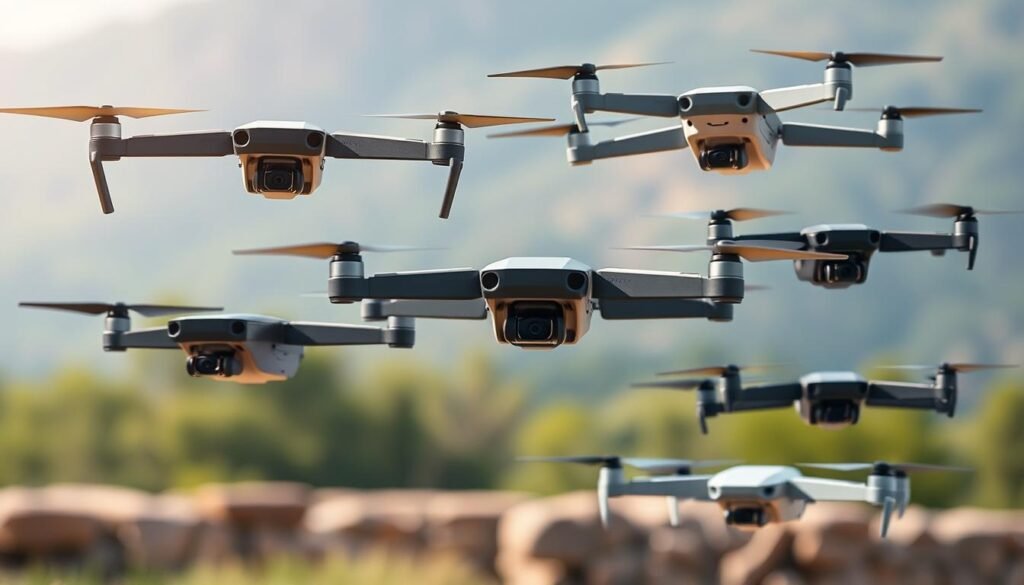
Drones with thermal cameras and AI are also used to find missing people in hard-to-reach places. As drone technology and drone innovations keep getting better, we’ll see even more cool uses for drones in the future.
Popular Applications and Uses of Flying Drones
Drones are used in many ways, from fun to work. They help with aerial photos, inspections, and surveys. These are big uses for drones. The third source says drones are great for aerial photos, inspections, and surveys. This shows how important drones are in different areas.
Some of the key drone applications include:
- Aerial photography and videography, which provide a fresh perspective on the environment and facilitate capturing challenging surveys.
- Industrial and construction applications, such as infrastructure inspection and maintenance, which have led to cost reduction, improved safety, and efficient access to hard-to-reach locations.
- Agricultural and environmental monitoring, where drones play a critical role in tracking ecosystem health, wildlife populations, and combatting illegal activities.
- Emergency services and search operations, where drones have significantly improved the speed and effectiveness in locating missing persons and assessing damage.
Drones are versatile and can change many industries and our lives. They bring many benefits and new ideas. As drone tech gets better, we’ll see even more cool uses for them.
Exploring drones opens up many exciting possibilities. You’ll see their uses from fun flying to serious work. You’ll get to see the benefits of drone technology yourself.
Understanding Drone Regulations and Safety Guidelines
Before you fly your drone, it’s key to know the drone regulations and safety rules. In the U.S., the Federal Aviation Administration (FAA) oversees drone safety and enforces drone laws. You must register your drone with the FAA if it’s over 250 grams. This costs $5 and lasts for three years.
Drone flying can be for fun or for work. For fun flying, you need to follow certain rules. For work flying, you need a Part 107 license. This license requires passing a 60-question exam. You can learn more about becoming a drone pilot and getting a Part 107 license at this link.
Important drone safety tips include keeping the drone in sight, flying no higher than 400 feet, and avoiding no-fly zones. Knowing where you can fly and how to handle conflicts is also vital. By following these tips and knowing the drone laws, you can have a safe and fun flying experience.
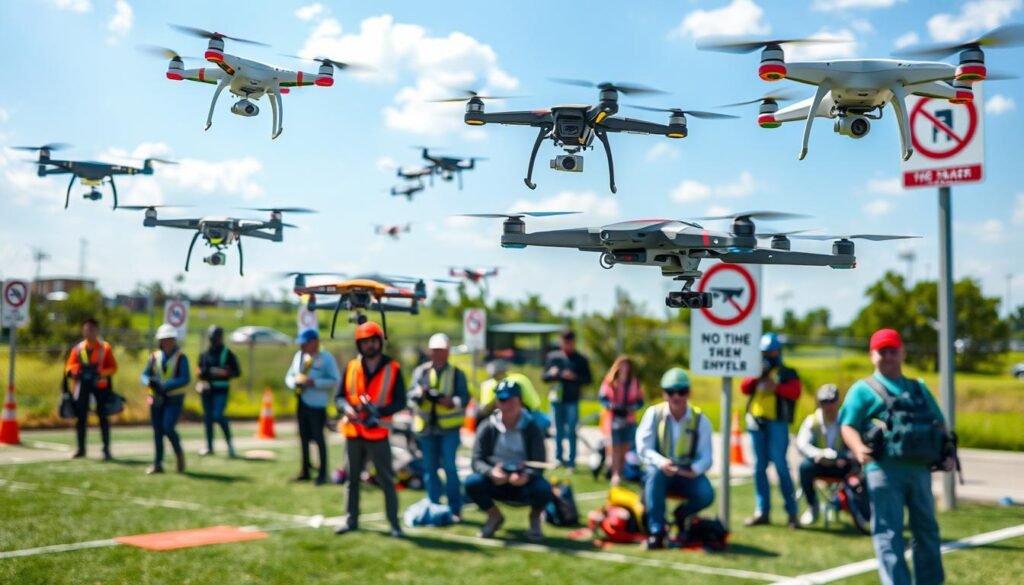
It’s also important to remember that drone regulations differ by country and region. Knowing the specific rules for your area is essential. This helps ensure drone safety and responsible flying, which is important for the drone industry’s growth.
Mastering Drone Flight: Tips for Beginners
Starting your drone journey is exciting. It’s key to learn the basics of drone training and safety. To get better, practice, be patient, and stay dedicated. Begin by mastering basic controls like hovering and moving.
For more tips, check out drone training resources. They offer guides and advice for newbies.
Drone safety is vital. Always check the weather before flying. Be mindful of your surroundings and keep a safe distance from things and people. Features like obstacle avoidance and Return to Home (RTH) help keep you safe.
To get better, try flying in circles and using yaw to turn. Online, you can find drone reviews and tutorials for beginners. Always follow local drone rules and enjoy your flights!
- Start with simple flights and gradually increase complexity
- Practice in open areas, away from obstacles and people
- Be aware of weather conditions and drone safety features
Selecting Your Perfect Drone: Buying Guide
Choosing the right drone involves looking at your budget, what features you need, and the brand. A good drone buying guide is key to making a smart choice. With many drones out there, think about how you plan to use it. Is it for fun, taking photos from the air, or for work?
As you start looking for a drone, read drone reviews from trusted sources. This will help you understand the good and bad of each drone. Look at the drone’s flight time, how far it can go, and the quality of its camera. For example, the DJI Mini 3 has a long flight time and a big range, making it great for those who need a reliable drone.
Important features to think about include:
- Flight time and range
- Camera resolution and quality
- Obstacle avoidance and safety features
- Portability and ease of use
By considering these points and reading drone reviews, you can find the perfect drone for you. Whether you’re new to drones or have lots of experience, a well-researched drone buying guide will help you choose wisely. This way, you’ll get the most out of your drone.
Maintaining and Caring for Your Drone
Keeping your drone in top shape is key to its long life. Regular checks every 10-20 flights can help your drone’s parts last longer. This includes batteries, motors, cameras, and gimbals. By sticking to a maintenance plan, you can avoid problems and keep your drone safe and reliable.
For your drone to work its best, clean it well, store it right, and fix it when needed. A cool, dry spot is best for storing your drone. This keeps its electronics safe from heat and moisture. Also, use protective cases and secure parts like propellers and gimbals to avoid damage when moving.
Here are some important drone care tips:
- Always update your drone’s firmware and calibrate the compass and IMU regularly.
- Replace propellers if they’re cracked, deformed, or damaged.
- Calibrate your camera for accurate data and protect it from dust and dirt.
- Use a cover to shield the gimbal and keep it dust-free.
By following these guidelines and keeping up with drone maintenance and drone repair, your drone will stay in great shape. It will keep giving you top-notch performance and reliability.
The Future of Drone Technology and Innovation
Exploring drones reveals a bright future with AI, autonomy, and connectivity. A report from Technology Review shows drones’ vast uses in fields like agriculture and healthcare. They can even fly into severe weather to help forecast.
Drones are mapping mountains in Switzerland to predict avalanches. Amazon is working on drone delivery systems. Their drones can carry up to 5 pounds and fly within a one-hour radius.
Researchers are looking into new drone battery types. This could make drones more efficient and useful. Drones could help in emergencies and even fight wildfires.
The benefits of drone advancements include:
- Improved efficiency and range
- Enhanced safety and security
- Increased accuracy and precision
- Cost-effectiveness and reduced labor
The drone future looks promising. Drone innovations and drone advancements will change many industries. For more on drone technology, visit Own Drones.
Conclusion: Embracing the World of Flying Drones
The world of flying drones is exciting and always changing. Drones are becoming key tools in many fields. They help in agriculture, disaster relief, construction, and more.
The future of drones looks bright. We can expect better flight control, longer battery life, and more carrying capacity. Keeping up with drone rules and safety is important for everyone.
Getting into drones means finding new ways to use them. You could use them for photos, farming, or improving your business. There’s a drone solution for almost any need.
Keep learning and staying safe as you explore drones. The possibilities are endless, and you can help shape the future.
